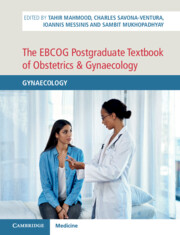Book contents
- The EBCOG Postgraduate Textbook of Obstetrics & Gynaecology
- The EBCOG Postgraduate Textbook of Obstetrics & Gynaecology
- Copyright page
- Dedication
- Contents
- Videos
- Contributors
- Preface
- Section 1 Basic Sciences in Gynaecology
- Section 2 Menstrual Disorders
- Chapter 6 Paediatric and Adolescent Gynaecology
- Chapter 7 Heavy Menstrual Bleeding
- Chapter 8 Management of Uterine Fibroids
- Chapter 9 Early-Onset Endometriosis
- Chapter 10 Chronic Pelvic Pain
- Section 3 Reproductive Endocrinology and Infertility
- Section 4 Contraception and STIs
- Section 5 Post-Reproductive Care
- Section 6 Vulva and Vagina
- Section 7 Cervix
- Section 8 Uterus
- Section 9 Ovary and Fallopian Tubes
- Section 10 Operative Gynaecology
- Section 11 Public Health Issues in Gynaecology
- Section 12 Miscellaneous
- Index
- Plate Section (PDF Only)
- References
Chapter 6 - Paediatric and Adolescent Gynaecology
from Section 2 - Menstrual Disorders
Published online by Cambridge University Press: 24 November 2021
- The EBCOG Postgraduate Textbook of Obstetrics & Gynaecology
- The EBCOG Postgraduate Textbook of Obstetrics & Gynaecology
- Copyright page
- Dedication
- Contents
- Videos
- Contributors
- Preface
- Section 1 Basic Sciences in Gynaecology
- Section 2 Menstrual Disorders
- Chapter 6 Paediatric and Adolescent Gynaecology
- Chapter 7 Heavy Menstrual Bleeding
- Chapter 8 Management of Uterine Fibroids
- Chapter 9 Early-Onset Endometriosis
- Chapter 10 Chronic Pelvic Pain
- Section 3 Reproductive Endocrinology and Infertility
- Section 4 Contraception and STIs
- Section 5 Post-Reproductive Care
- Section 6 Vulva and Vagina
- Section 7 Cervix
- Section 8 Uterus
- Section 9 Ovary and Fallopian Tubes
- Section 10 Operative Gynaecology
- Section 11 Public Health Issues in Gynaecology
- Section 12 Miscellaneous
- Index
- Plate Section (PDF Only)
- References
Summary
Children and adolescents presenting with common and rare gynaecological conditions are described in this chapter. Communication needs to be sensitive and appropriate for age and development to retrieve as much information as possible.
Puberty heralds the development of secondary sexual characteristics, gonadal maturation, and start of reproductive capacity. Pubertal disorders can be divided into precocious and delayed puberty. Menarche is an important marker of puberty and menstruation should be seen as a vital sign. Oligomenorrhoea is pathological over time and most girls with oligomenorrhoea develop polycystic ovary syndrome (PCOS).
Sex development in the human is the result of a complex interaction involving production and response to sex hormones which is regulated by genetic and environmental factors. Disorders of sex development occur when an individual’s sex development takes a different path.
Keywords
- Type
- Chapter
- Information
- The EBCOG Postgraduate Textbook of Obstetrics & GynaecologyGynaecology, pp. 47 - 54Publisher: Cambridge University PressPrint publication year: 2021

